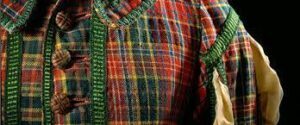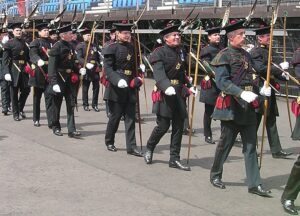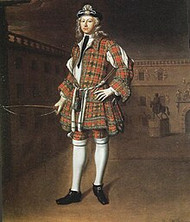The Scottish Royal Company of Archers
Posted by Charles MacGregor on May 12th 2018
Originally published February 2009. Written for The Celtic Croft by Charles MacGregor of MacGregor Historic Games.

The Scottish Royal Company of Archers
I was recently looking up something in the book A Short History of the Scottish Dress by R.M.D. Grange (1966) and rediscovered a tidbit that I thought it would be fun to share. Most people assume that the Black Watch was the first official military unit to be assigned a tartan, but Grange claims that:
"The first military body, under Government control, to adopt tartan as a part of their uniform was, not as might have been expected, a Highland regiment, but a Lowland one...The Royal Company of Archers in 1715 adopted a red tartan sett for their uniform. The first Highland regiment to wear tartan was the famous Black Watch (42nd) raised in 1729."
The Company of Archers received its Royal Charter in 1704 and is a ceremonial unit that serves as the Sovereign's Bodyguard in Scotland, a role it has performed since 1822 and the reign of King George IV, when the company provided a personal bodyguard to the King on his visit to Scotland. (Although members of the Company served in the military, in my brief look at them I have not found a reference to the Royal Company itself ever fighting as a unit.) The company was revitalized in 1713 and a new tartan uniform was created for its members. Tartan had become fashionable at the time as an expression of anti-Union and pro-Jacobite sentiment. It seems a little ironic that this body guard for the crown seems to have had a number of members who were known Jacobites.

Not long ago I happened stumble on to a photograph of an early 18th century uniform of the Royal Company of Archers on the site of the National Museum of Scotland:
Although the Company was formed in 1676 as a private club originally created to promote the sport of archery in Edinburgh, there is a legend that suggests (on doubtful authority) that in an early form it was created by the commissioners appointed by James I of Scotland for overseeing the exercise of archery. These commissioners supposedly selected the best bowmen under their charge and formed them into a company to attend the king as a body guard on "perilous occasions." There is also a tradition in the Company which says that the body of the Scottish king, when located on the battlefield of Flodden in 1513, was found covered and surrounded by the bodies of his archers' guard.
Unfortunately, the oldest records of the Company are said to have been destroyed in a fire at the end of the 16th century. However, the Musselburgh Arrow, a shooting prize for which the members have competed since 1676 actually has medals attached to it going back as far as 1603 and is claimed to be the oldest sporting trophy in the world. But the early competitions may have been open to all comers and not confined to the members of the Company.
Not long after their establishment the members settled on a uniform for occasions when they appeared in public consisting of a white vest, green breeches, and bonnet, with no mention of a coat or jacket. They ultimately fixed upon a "Stuart" tartan for the coat, and resolved that the lining should be " of fine white shalloon, (A lightweight
wool or worsted twill fabric) and white stockings, with a white lin

ning bow-case, with a green worsted bob, and a blew bonnet with a St Andrew and a Coque (cockade) of white and green ribbons, and the officers are allowed to trim or adorn their habits as they think proper, according to their ranks." The shalloon was found to be unavailable, so members were allowed to line their coats with anything that was white except silk. The only difference in an officer's dress was the trimming; the uniform itself was to be made of the same stuff, both inside and outside, as the others.
The Royal Company currently has about four hundred active members and a non-active retired list. Their current duties include attending the Sovereign at various functions in Scotland, including the Order of the Thistle investitures at The High Kirk of Edinburgh (St Giles Cathedral), investitures at the Palace of Holyroodhouse, and the presentation of new colours to Scottish regiments. .
A full-text version of the book The History of the Royal Company of Archers, by James Balfour Paul (1875) can be read online or from Google Books.
In response to the original publication of this article on the Scottish Royal Company of Archers. Mr. Steve F. was kind enough to share this:
"Great article - I really enjoy receiving these! The (tartan) uniform referenced above is of a style known as a "hunting frock," which in various forms was a very popular uniform item during the American Revolution. They tended to be pretty rustic, and in the early years of the Rev many soldiers wore their own. Some units adopted the hunting frock as their official uniform, early in the War, before the French started importing patterns and materials, as well as finished garments, for a more standard regimental coat.
This frock is fancied up some for ceremonial wear. The hunting frock in general seems like an appropriate choice for a company of citizen-archers!"
Update


